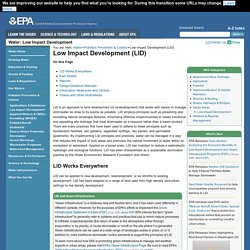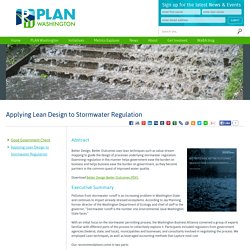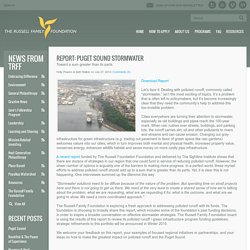

Symposium Resources - LID (Olympia) LID Project Showcasing. WA State Department of Ecology - Resources & Trainings. Puget Sound Partnership. Stewardship Partners & 12,000 Rain Gardens. Washington Stormwater Center. Code Innovations: Site and Stormwater. Asphalt and concrete removal from urban areas. Based in Portland, Oregon. Low Impact Development Technical Guidance Manual for Puget Sound. Integrating LID into Local Codes: A Guidebook for Local Governements. Rain Garden Handbook for Western Washington. City of Olympia Low Impact Development (LID) Code Revisions Page. Thurston County Low Impact Developement (LID) Barriers Analysis. UW Certificate in Green Stormwater Infrastructure, Design, and Management. EPA - Low Impact Development (LID) Site. A green roof in the middle of dense urbanization can slow down and reduce rainfall runoff from the roof in Arlington County, Virgina.

(Photo courtesy of Ansu John) Green landscaping within impervious surfaces, such as parking lots, can help reduce runoff. On this Page LID is an approach to land development (or re-development) that works with nature to manage stormwater as close to its source as possible. LID employs principles such as preserving and recreating natural landscape features, minimizing effective imperviousness to create functional and appealing site drainage that treat stormwater as a resource rather than a waste product.
LID Works Everywhere LID can be applied to new development, redevelopment, or as retrofits to existing development. LID and Green Infrastructure "Green infrastructure" is a relatively new and flexible term, and it has been used differently in different contexts. Top of Page Fact Sheets Reports Design and Guidance Manuals. Applying Lean Design to Stormwater Regulation. Abstract Better Design, Better Outcomes uses lean techniques such as value stream mapping to guide the design of processes underlying stormwater regulation.

Examining regulation in this manner helps government ease the burden on business and helps business ease the burden on government, as they become partners in the common quest of improved water quality. Executive Summary Pollution from stormwater runoff is an increasing problem in Washington State and continues to impact already stressed ecosystems. According to Jay Manning, former director of the Washington Department of Ecology and chief of staff to the governor, “Stormwater runoff is the number one environmental issue Washington State faces.”
With an initial focus on the stormwater permitting process, the Washington Business Alliance convened a group of experts familiar with different parts of this process to collectively explore it. Floodplains by Design. Floodplains by Design Budget Proposal. Background The Department of Ecology wants to promote a broad approach to floodplain management, combining efforts that have previously been approached through single-issue programs focused on reducing flood hazards, restoring floodplain habitat, or investing in other floodplain activities.

Achieving these multiple objectives will need increased funding at the local level. There are two goals of the Floodplains by Design (FbD) effort: Promote the reduction of flood risks and floodplain ecosystem recovery while maintaining or improving agricultural production, water quality, and open space/recreation. Improve the coordination of public funding for floodplain efforts. In 2013, the Department of Ecology was successful in securing legislative funding through the FbD effort. In May 2014, Ecology received 71 project applications, in response to our request for summary project and budget information. Self-guided LID tour Map of Puyallup, Pierce County & Tacoma.
Economics of LID (2007) - Good Framework for Updating. Report: Puget Sound Stormwater, The Russell Family Foundation. Toward a sum greater than its parts.

Let’s face it: Dealing with polluted runoff, commonly called “stormwater,” isn’t the most exciting of topics. It’s a problem that is often left to policymakers, but it’s become increasingly clear that they need the community’s help to address this too-invisible problem. Cities everywhere are turning their attention to stormwater, especially as old buildings and pipes reach the 100-year mark. When rain rushes over streets, buildings, and parking lots, the runoff carries dirt, oil and other pollutants to rivers and streams and can cause erosion. Changing out gray infrastructure for green infrastructure (e.g. trading out pavement in favor of green space like rain gardens) welcomes nature into our cities, which in turn improves both mental and physical health, increases property value, conserves energy, enhances wildlife habitat and saves money on more costly pipe infrastructure.
The Russell Family Foundation Stormwater Report.